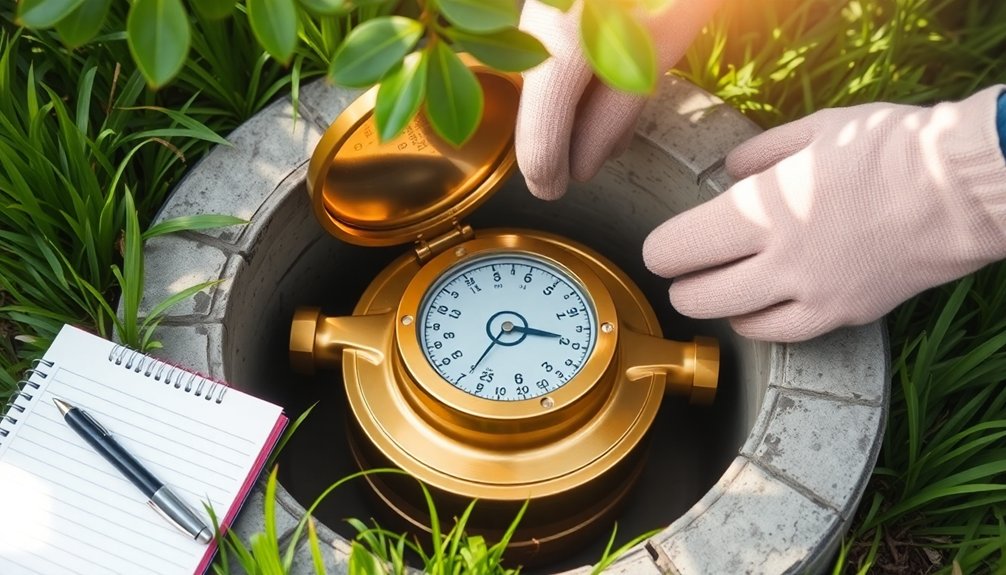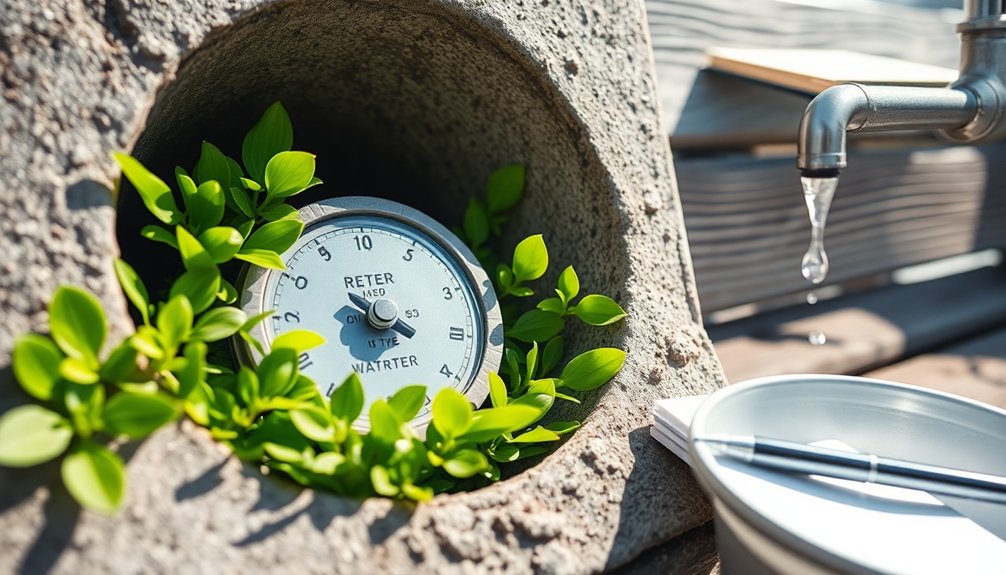To find your water meter, look for a box near your property’s front yard, close to the curb or sidewalk. Carefully pry open the lid to access it. Regularly reading your meter helps track water usage, revealing leaks and preventing high bills. If you notice unusual spikes in your water bill, it might indicate a problem. By monitoring your consumption and making informed choices, you can cut down on utility costs. There’s more to explore on maximizing savings.
Locating Your Water Meter
Although it might seem intimidating, locating your water meter is a straightforward task that can save you money and help you keep track of your water usage.
Typically, water meters are found in a box near your property line, often in the front yard, close to the curb or sidewalk. To access the meter, use a long screwdriver to gently pry open the lid of the meter box.
Water meters are usually located in a box near your property line, often in the front yard by the curb.
You’ll encounter either a digital meter, which might need light to activate, or an analog meter with a large red sweep hand indicating usage. Regularly checking your water meter can help you identify water leaks and unusual water usage, allowing you to reduce your utility bills effectively. Utilizing tools that enhance expense management can also contribute to overall savings on household costs.
Understanding the Importance of Reading Your Meter
Locating your water meter is just the first step; understanding its readings is vital for managing your water usage effectively. Regularly checking your meter allows you to track water consumption patterns, helping identify leaks or unauthorized usage that can inflate your water bills.
Water Utility Management relies on accurate meter readings to guarantee fair billing and minimize water loss, so it’s important you monitor your usage. Keeping a log of your readings over time fosters a better understanding of your typical consumption, promoting proactive water conservation efforts. Additionally, automation of expense tracking helps improve accuracy in monitoring utility usage and identifying cost-saving opportunities. Updated meters with ultrasonic technology reduce measurement errors, providing clearer insights into billing spikes. Performing regular leak tests by checking your meter when no water is in use can prevent unexpected increases in your bills.
How to Read Your Water Meter

Reading your water meter accurately is essential for effective water management.
First, identify whether you have a digital or analog water meter. Digital meters display your water used and flow rate directly, while analog meters feature a large red sweep hand to indicate usage.
Make certain all water appliances are turned off before taking a reading to guarantee accuracy. Record the meter’s number, keeping in mind that water usage is measured in either cubic feet or gallons—100 cubic feet equals 748 gallons.
Ensure all water appliances are off before reading your meter for precise results, noting that 100 cubic feet equals 748 gallons.
Regularly check your meter to track consumption patterns. This practice can help you spot leaks or other issues that may lead to high water bills, allowing you to take action before costs escalate. Additionally, monitoring consumption patterns is crucial for understanding your overall financial health and can lead to more effective budgeting strategies.
Signs of a Faulty Water Meter
Here are some signs that indicate you might’ve a faulty water meter:
- Unusually High Water Bills: If your water bill spikes despite consistent usage habits, your meter may be malfunctioning.
- Erratic Readings: Fluctuating dials or displays can signal a fault, making it hard to trust the amount of water recorded.
- Movement When Idle: If the meter dials move when no water’s being used, it suggests leakage or a broken meter.
If you notice these signs, it’s important to investigate further to avoid paying inflated water bills due to inaccuracies from a faulty water meter. Additionally, conducting regular billing process reviews can help you identify and address any discrepancies in your utility charges more effectively.
Performing a Leak Test

When you suspect a leak in your plumbing system, performing a leak test is a straightforward yet effective method to confirm your concerns.
Start by turning off all water appliances, including icemakers and irrigation systems, to guarantee no water is being used. Record the initial reading from your water meter; this is your 1st Reading.
Wait for 20 minutes without using any water, then take a second reading, known as your 2nd Reading. If the flow rate between the 1st and 2nd Readings is greater than 0, it indicates a leak may be present.
Regular leak testing can help you identify unintended water flow early, preventing spikes in your water bill caused by undetected leaks. Additionally, using tools like expense management apps can assist in tracking your utility bills and identifying unusual patterns in your expenses.
Benefits of Installing a Water Meter
Installing a water meter offers significant advantages that can enhance both your financial savings and water management. Here are three key benefits:
- Cost Savings: You could save hundreds of pounds annually, as bills are based on actual usage, benefiting larger households with fewer residents.
- Leak Detection: By monitoring your consumption, you can quickly identify leaks, preventing unexpected spikes in your water utility bills and avoiding potential property damage.
- Water-Saving Devices: Combining a water meter with water-saving devices can yield additional savings of around £60 per year for a family of four, further reducing excessive water use. Additionally, using sustainable practices in your water usage can contribute to overall environmental conservation.
Exploring Social Tariffs and Assistance Programs

Many households may not realize that social tariffs and assistance programs are available to help alleviate the financial burden of water bills, particularly for those struggling to make ends meet.
Social tariffs can offer discounts of up to 90% on water bills for low-income households earning around £26,000 annually. With about 1.6 million eligible households potentially missing out, it’s vital to explore these options.
Water suppliers, like Affinity Water and Anglian Water, provide specific support, including capped annual bills at £143.40 and reductions of up to 50%.
Additionally, the WaterSure scheme assists families with high water needs. Supporting sustainable businesses not only helps with utility costs but also promotes ethical practices in the community.
Don’t hesitate to reach out to Citizens Advice for help in applying for charity grants and accessing the Priority Services Register for further support.
Tips to Reduce Water Consumption and Save Money
Reducing water consumption isn’t just about conserving an essential resource; it can also lead to significant savings on your utility bills.
By implementing a few practical strategies, you can effectively reduce water consumption and avoid potential water damage from leaks.
- Monitor your water usage: Regularly check your meter to identify unusual patterns or leaks.
- Utilize water-saving devices: Install free devices like shower timers and cistern bags to improve efficiency, potentially saving you around £60 annually.
- Opt for water-efficient appliances: These appliances not only save water but also cut down on your utility costs in the long run. Additionally, understanding financial literacy can help you make informed decisions about investments in water-saving technologies.
Conclusion
By taking the time to locate and read your water meter, you can gain valuable insights into your water usage and identify potential leaks. Remember, “a penny saved is a penny earned.” By implementing the tips outlined, like performing a leak test and exploring social tariffs, you can effectively cut down on your utility bills. Understanding your water consumption not only saves you money but also promotes responsible usage, contributing to a sustainable future for everyone.


